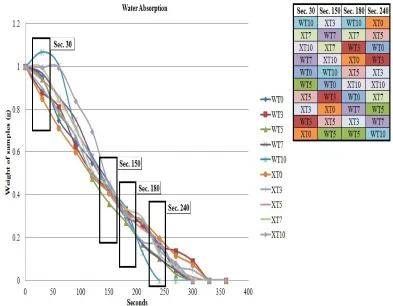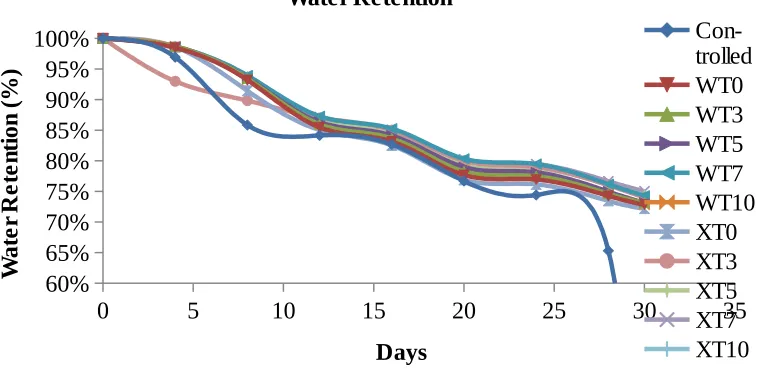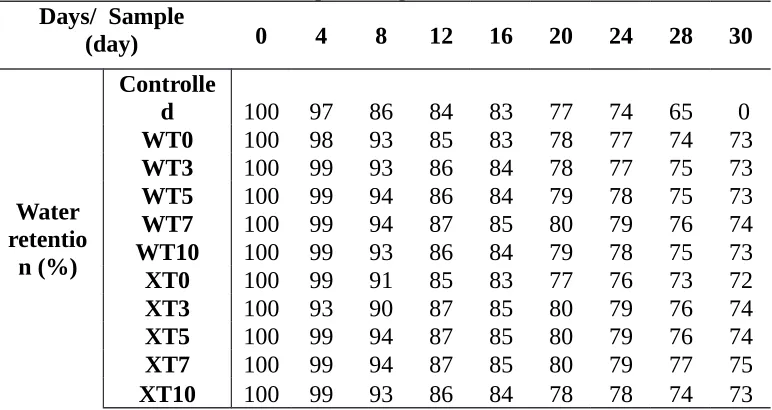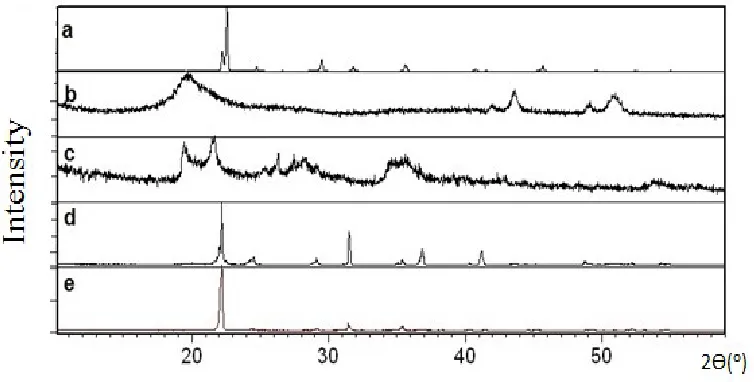EFFECT OF CHITOSAN GELATINIZATION TEMPERATURE ON WATER ABSORPTION AND WATER RETENTION OF CHITOSAN BASED UREA
FERTILIZER
N. Mohamad*, A. H. Nor Nadiah, A. R. Jeefferieand D. Mohd Fairuz
Department of Engineering Materials, Faculty of Manufacturing Engineering, Universiti Teknikal Malaysia Melaka,
76100 Durian Tunggal, Melaka, Malaysia
*Email: [email protected]
Phone: +606-555-2000; Fax: +606-331-6247
ABSTRACT
Chitosan is highly potential to be blended together in urea fertilizer for slow release properties due to its unique polymeric cationic character and gel forming properties. In agriculture, the slow release properties are normally indicated by the ability of urea fertilizer to absorb and retain water since nitrogen is released to the environment once urea is in contact with water or enzyme. This paper investigates the effect of chitosan content and gelatinization temperature on physical properties of chitosan based urea fertilizer. The chitosan content was varied from 0, 3, 5, 7 and 10 pph. Chitosan based urea fertilizer was prepared through a direct wet mixing using laboratory set up consist of beaker, magnetic stirrer and hotplate. The properties of chitosan based urea fertilizer
were compared at two different mixing temperatures which are 60oC and room
temperature of 25 ± 3oC. The mixture was then dried in an oven at 60oC for 8 hours
before fabricated into pellet using a hydraulic hand presser. Water absorption and water retention analysis were carried out to measure amount of water intakes and amount of water retain in fertilizer. It was observed that mixing temperature has negligible effect on water retention of the fertilizers. However, gelatinization at room temperature resulted in fertilizers with better water absorption and water retention properties than the one gelatinized at 60C. These results were supported by X-Ray Diffraction (XRD) analysis conducted on the fertilizers. As a conclusion, the gelatinization temperature plays important role to improve water retention and water absorption capability of chitosan based urea fertilizers. Furthermore, the presence of chitosan improved crystallinity of urea fertilizers as indicated by XRD analysis.
Keywords: Chitosan; Urea Fertilizer; Water Retention; Water Absorption; X-Ray
Diffraction
INTRODUCTION
for growth and development of crops (Yip et. al. 2013). There are various types of fertilizer either organic or synthetic fertilizers. An important synthetic fertilizer is urea fertilizer; a major source of nitrogen nutrient for plants (Papangkorn et. al., 2008). Unfortunately, the practical use of this fertilizer is not efficient due to the loss during application. Potential hazards of fertilizers to the environment have resulted in limitation of their use. The used of conventional fertilizers may lead to concentration levels that are too high for effective action. According to Chandra and Rustgi (1998), high concentration may produce undesirable side effects either in the target area, which could lead to crop damage, or in the surrounding environment. Therefore, it is important to improve its performance during utilization. To address these problems, slow and controlled-release technology in fertilizer is considered as suitable method to efficiently supply nutrients to plants and decrease the loss and contamination. These technologies are designed for the fertilizer to release their nutrient contents gradually and to coincide with the nutrient requirement of a plant. These properties can be physically imparted in fertilizers by coating techniques on granule of conventional fertilizers with various materials that reduce their dissolution rate (Wu et. al., 2008; Hanafi et. al., 2000).
Slow release fertilizers are made to release their nutrient contents gradually and to coincide with the nutrient requirement of a plant (Wu et. al., 2008). The release and dissolution rates of water-soluble fertilizers depend on the coating materials. Recently, the use of slow release fertilizer is a new trend to save fertilizer consumption and to minimize environmental pollution (Wu et al., 2008). According to Hart (1998) slow release fertilizer reduces toxicity of plant due to slow release of nutrients into the soil solution. These materials usually are comparative expensive. Slow release N fertilizers offer the potential for reduced N leaching if the N fertilizer release can be matched to crop demand. These fertilizers can be physically prepared by coating granules of conventional fertilizers with various materials that reduce their dissolution rate. The release and dissolution rates of water-soluble fertilizers depend on the coating materials. Nowadays, chitosan has drowned tremendous attention among researchers. It is proven by numbers of research conducted in this area quite recently. There are various studies regarding chitosan nano-particles (Shi and Tang, 2009), PVOH/chitosan-blended films (Park et. al., 2001), mechanism of chitosan degradation by gamma and e-beam irradiation (Gryczka et. al., 2009), FTIR studies of chitosan (Osman and Arof, 2002; Pawlak and Mucha, 2002; Kadir et. al., 2010) as well as chitosan as biosensor (Ibrahim et. al., 2010).
Our research team investigates the potential of chitosan as a biodegradable binder which able to hold urea powder in granular form as well as for slow release contributor. The urea fertilizer was chosen since it is a main source of nitrogen (N) for plant nutrient. In this paper, a process parameter which is gelatinization temperature is investigated. Two different temperatures were selected in order to study its effect to the properties of urea fertilizer’s pellet which at the end is used to select the best temperature which effective for cost and performance. This study involved a new approach of introduction chitosan in fertilizer where it was blended together with urea powder to impart slow release properties instead of coating at outer layer of fertilizer which mostly carried out by other researchers (Riyajan et. al., 2012; Han et. al., 2009). The performance of chitosan based urea fertilizer was measured from amount of water absorption, water retention and structure crystallinity via XRD analysis.
EXPERIMENTAL SET UP Raw Materials
Chitosan powders (419419 Aldrich) with particle size between 1.320µm – 590.102µm were purchased from Sigma Aldrich. Industrial grade bentonite with particle size of 1.320µm – 83.707µm and urea powder (QReC) with particle size of 5µm – 590.102µm) and molecular weight of 60.06g/mol were supplied by local company.
Preparation of Chitosan Based Urea Fertilizer (CBUF)
Samples were prepared through direct wet mixing method using an experimental set up which consist of beaker, hotplate and magnetic stirrer. There were two different
temperatures investigated for binder synthesis; 60oC and room temperature of 25 ± 3oC.
Firstly, chitosan and bentonite were weighed and placed in a beaker. Then, it was stirred
in 20 ml distilled water either at 60oC or room temperature (~ 25 ± 3C) using a
magnetic stirrer at 300 rpm until gelatinization state (this state is achieved when the thin watery liquid changed to a viscous liquid). Then, urea was added to the mixture and stirred until it was well blended for 20 minutes. Next, the mixture was dried in a
conventional oven at 60oC for 8 hours. Further testing was performed to the samples
after one day conditioned at room temperature. Five formulations of different chitosan content were prepared at constant amount of water, urea and bentonite as shown in
Table 1. WT is sample that mixed using 60oC and XT is representing binder mixing in
room temperature where number denotes the amount of chitosan in pph.
Table 1. Formulation of chitosan based urea fertilizers
Sample
Code WT0 WT3 WT5 WT7 WT10
XT
0 XT3 XT5 XT7 XT10
Urea (pph) 100 100 100 100 100 100 100 100 100 100
Chitosan
(pph) 0 3 5 7 10 0 3 5 7 10
Bentonite
(pph) 1 1 1 1 1 1 1 1 1 1
Measuring Water Absorbency of CBUF
Water absorption was carried out to determine the amount of water absorbed by the samples at certain amount of time (Kakade et. al., 2010). One (1) gram of CBUF was immersed in 20ml distilled water. The wetted sample was taken out after 30 seconds, placed on a tissue paper to drain the excess water and weighed. The reading was collected at every 30 seconds for 300 seconds.
Measuring Water Retention of CBUF in Soil
Two (2) grams of CBUF was mixed with 200g of dry sandy soil and kept in a beaker.
Then, 200 g of tap water was slowly added into the beaker and weighed (W1). The
beakers were left at room temperature and weighed every 4 days (W2) until 30th day. The
water retention ratio of soil (WR%) was calculated using Eq.(1).
Water retention, WR (%)= W2
W1 ×100 (1)
X-Ray Diffraction (XRD) Measurement
The structural characteristics of the films were studied by X-ray diffractometer (XRD) Xpert Pro MPD from PANalytical using radiation of CuKα. Specimen was ground to powder form and placed tightly in a sample holder before testing. Analysis was carried out at 25oC with degree of 2 .Ɵ
RESULTS AND DISCUSSION Water Absorbency of CBUF
It is well known that urea will easily dissolve in water (Zangi et. al., 2009) and normally takes around 270 seconds for urea to completely dissolve in water. Figure 1 shows water absorption of all samples. It is clearly observed that samples with high chitosan content (around 5 to 10 pph) shown the highest water absorption rate during the first 30 seconds for both gelatinization temperatures. This phenomenon is a direct correlation with the increase hydrophilicity properties of the fertilizers with increasing chitosan content. The amount of absorbed water increases as the amount of the hydrophilic component increases in the compound (Nor Nadiah et. al., 2013). Chitosan are hydrophilic materials which is hydrophilic polymers can absorb and retain liquids thousands of times their own weight (Wu et. al., 2008).
represents dissolution and diffusion out of fertilizers component such as urea, bentonite and chitosan into water. It was most contributed by urea content since urea made up most of the fertilizers weight; ~98% of the total weight.
During the first 150 seconds, there was still no clear specific pattern to draw a concrete conclusion regarding the influence of gelatinization temperatures to the absorption rate at this point. This was due to other variables that may present during this study including environment factors and surface reactivity. However, when the whole pattern was closely examined it is evident in most of the samples that gelatinization at 60C shows the highest water absorption rate at the beginning and the fastest weight loss if compared to gelatinization at room temperature.
Figure 1. Water absorption for all samples (WT0, WT3, WT5, WT7, WT10, XT0, XT3, XT5, XT7, and XT10) in water for 360 seconds.
Figure 2. Physical diagram for samples 0, 3, 5, 7, and 10 pph chitosan after 180 seconds absorb water.
Water Retention of CBUF in Soil
Water absorbency is an important criterion for slow release fertilizers (Wu et. al., 2008) since presence of water will cause a gradually release of urea to environment. However, water absorption should be assisted with water retention since the probability of fertilizers to decompose would be very high without significant water retention ability. This is because the increase in permeability in swollen matrix will apparently facilitate the urea to diffuse out very fast from fertilizers. Furthermore, it is an important characteristic for agriculture activities in dry and desert regions for saving water especially to sustain plant growth (Wu et. al., 2008; Liang et. al. 2007).
In this study, water retention analysis was conducted in 30 days. The water retention percentage of fertilizers for both gelatinization temperatures at different chitosan content is presented in Figure 3 and Table 2. In general, the water retention was slowly decreasing with time except for controlled samples which exhibits zero (0)
percent (%) at 28th day due to no water left after this point. Control was soil sample
without any samples. When examine Figure 3, it was noticed that no obvious difference in water retention percentages pattern for different gelatinization temperature.
0 5 10 15 20 25 30 35
60% 65% 70% 75% 80% 85% 90% 95% 100%
Water Retention
Con-trolled WT0 WT3 WT5 WT7 WT10 XT0 XT3 XT5 XT7 XT10 Days
W
at
er
R
et
en
ti
on
(
%
)
[image:6.595.113.494.502.688.2]However, when the exact value in Table 2 was taken into account, CBUF with existence of chitosan around 3 to 7 pph shows the best water-retention capability. These samples exhibit slightly high ratio in water retention percentages during 30th day compared to other chitosan loading and control sample. Besides, it is clear from this table that fertilizers prepared at room temperature shows higher water retention than the one prepared at 60C. This finding is in good agreement with water absorption study except later study was conducting at apparently lower water contact which closer to actual application. Chitosan has capability to highly absorb water and retain the water in its structure for longer time before releasing its dissolved component into surrounding compared to fertilizers without chitosan. The water was stored in fertilizer and slowly released with the decrease of soil moisture (Wu et. al., 2008).
Table 2. Detail percentage of water retention Days/ Sample
(day) 0 4 8 12 16 20 24 28 30
Water retentio
n (%)
Controlle
d 100 97 86 84 83 77 74 65 0
WT0 100 98 93 85 83 78 77 74 73
WT3 100 99 93 86 84 78 77 75 73
WT5 100 99 94 86 84 79 78 75 73
WT7 100 99 94 87 85 80 79 76 74
WT10 100 99 93 86 84 79 78 75 73
XT0 100 99 91 85 83 77 76 73 72
XT3 100 93 90 87 85 80 79 76 74
XT5 100 99 94 87 85 80 79 76 74
XT7 100 99 94 87 85 80 79 77 75
XT10 100 99 93 86 84 78 78 74 73
X-Ray Diffraction (XRD) Analysis
X-ray diffraction analysis was performed to show crystalline and amorphous structure present in CBUF samples compared with raw urea, chitosan and bentonite. Figure 3 shows the X-ray diffractogram of raw urea, chitosan, bentonite and CBUF gelatinized at 60C temperature (WT) and without temperature (XT). From the diffractogram, urea shows distinct peak which represent a crystalline powder while broaden peak for chitosan shows amorphous structure. Moreover, bentonite powder shows broadening peak with certain level of crystallinity. Both CBUF samples either WT or XT exhibit
crystallinity closed to urea powder with strong identical peak at 22o which pointed back
Figure 4. XRD patterns of (a) Urea, (b) Chitosan, (c) Bentonite, (d) CBUF WT( chitosan 5pph), and (e) CBUF XT (chitosan 5pph).
When both peaks for WT and XT were closely examined, XT samples show slightly different pattern. This was postulated to be the effect of interaction between urea and chitosan which is an amorphous organic polymeric material. This interaction present at higher extent in XT if compared to WT. This observation was in-lined with better physical properties shown by XT than WT conducted in other analyses. Incorporation of urea bentonite and chitosan may results in physical or chemical interaction due to existence of active hydroxyl groups in chitosan structure that can act with urea or bentonite in aqueous medium. This situation is similar with the research conducted by Han et. al. (2009); when both urea and chitosan were mixed together. According to Ionita and Iovu (2012) the formation of chitosan crystal units is dependent upon the dissolved solvents. In this case, the usage of distilled water as solvent normally results in a very weak crystallization or amorphous structure of chitosan. For slow release fertilizers, crystalline polymer is favour because it tends to be stiffer, harder, and denser than amorphous polymers.
CONCLUSIONS
A chitosan based urea fertilizer was successfully prepared via wet mixing and compression technique. From the study, it can be concluded that gelatinization at room temperature produced samples which exhibit better water absorption and water retention
capability than the one gelatinized at 60oC. Formulations which show good balance
ACKNOWLEDGEMENTS
The authors acknowledge the Ministry of Higher Education Malaysia and Universiti Teknikal Malaysia Melaka (UTeM) for granting the Long Term Research Grant Scheme (LRGS/2011/FKP/TK02/1 R00001) of Onebaja-Next Generation Green and Economical Urea (Green Processing : Biodegradable Urea Granules) and facilities to carry out this project. We wish to sincerely thank the Faculty of Manufacturing Engineering UTeM which provided the expertise, equipment and technical assistance while we conducted our experiments.
REFERENCES
Aarnio, T., and Martikainen, P.J. 1995. Mineralization of C and N nitrification in Scots Pine Forest soil treated with nitrogen fertilizers containing different proportions of urea and its slow-releasing derivative ureaformaldehyde. Soil Biology & Biochemistry, 27(10): 1325-1331.
Chandra, R. and Rustgi, R. 1998. Biodegradable polymer. Progress in Polymer Science, 23: 1273- 1335.
Committee on Toxicology 1980. Formaldehyde – An assessment of its health effects. Board on Toxilogy and Environmental Health Hazards, Assembly of Life Sciences: 4-29. Gryczka, U., Dondi, D., Chmielewski, A.G., Migdal, W., Buttafava A., and Faucitano, A.
2009. The Mechanism of chitosan degradation by gamma and e-beam irradation. Radiation Physics and Chemistry,78(7-8): 543-548.
Guohua, Z., Ya, L., Cuilan, F., Min, Z., Caiqiong, Z. & Zongdao, C. 2006. Water resistance, mechanical properties and biodegradability of methylated-cornstarch/poly(vinyl alcohol) blend film. Polymer Degradation and Stability, 91: 703-711.
Hamdi, C.H., Mustafa, F.S., Hamit, C.M., Sabri, U.S., and Haluk, C.T. 2001. A review of the health effects of formaldehyde toxicity: 3.
Han, X., Chen, S., and Hu, X. 2009. Controlled-release fertilizer encapsulated by starch/polyvinyl alcohol coating. Journal of Desalination, 240: 21-26.
Hanafi, M. M., Eltaib, S.M., and Ahmad M.B. 2000. Physical and chemical characteristics of controlled release compound fertilizer. European Polymer Journal. 36: 2081-2088. Hart, J. 1998. Fertilizer and lime materials. Fertilizer Guide, 52: 1-5.
Hermary, H. 1980. Effects of some synthetic fertilizers on the soil ecosystem: 3.
Hojattie, M. M., Abrams, D. E., and Parham, T. M. 2004. Liquid chromatographic determination of urea in water-soluble urea-formaldehyde fertilizer products and in aqueous urea solutions: collaborative study. Journal of AOAC International, 87(2): 346-351.
Ibrahim, M., Mahmoud, A.A., Osman, O., Refaat, A., and El-Sayed, E.M. 2010. Molecular spectroscopic analysis of nano-chitosan blend as biosensor. Spectrochimica Acta Part A: Molecular and Biomolecular Spectroscopy, 77(4): 802-806.
Ionita, M. and Iovu, H., 2012. Mechanical properties, urea diffusion, and cell cultural response of poly(vinyl alcohol)-chitosan bioartificial mebranes via molecular modelling and experimental investigation. Composite Part B: Engineering, 43(5): 2464-2470. James, H.B. 2004. Formaldehyde exposure hazards and health effects: A comprehensive
review for embalmers: 2.
poly(vinyl alcohol)-chitosan blend doped with NH4NO3 polymer electrolyte membrane. Spectrochimia Acta Part A Molecular and Biomolecular Spectroscopy. 78(3): 1068-1074.
Kakade, S.M., Mannur, V.S., Kardi, R.V., Ramani, K.B., and Dhada, A.A. 2010. Evaluation of orally disintegrating tablets of sertraline. International Journal of Pharmaceutical Research & Development, International Standard Serial No. 0974-9446: 1-7.
Liang, R., Liu, M., and Wu, L. 2007. Controlled release NPK compound fertilizer with the function of water retention. Reactive & Functional Polymers, 67: 769-779.
Moore, W. P., Sansing J. E., and Williamson, H. D. 1976. US3970625 Production of urea formaldehyde concentrate. Allied Chemical Corporation.
Nor Nadiah A.H., Noraiham M., Lum Y.H., Mohd Fairuz D., Mohd Asyadi A., Mohd Haneesyah C.H., Mohd Khairul S.M.A., and Azizah S. 2013. The effect of chitosan content to physical and degradation properties of biodegradable urea fertilizer. Journal of Scientific & Innovative Research, 2(5): 893-902.
Osman Z., and Arof, A.K. 2002. FTIR studies of chitosan acetate based polymer electrolytes. Thermochimica Acta 48: 993-999.
Papangkorn ,J., Isaraphan, C., Phinhongthong, S., Opaprakasit, M., and Opaprakasit, V. 2008. Controlled-release material for urea fertilizer from polyactic acid. Advanced Materials Research, 55-57: 897-900.
Park, S.Y., Jun, S.T., and Marsh, K.S. 2001. Physical properties of PVOH/chitosan- blended films cast from different solvents. Food Hydrocolloids, 15( 4-6): 499-502.
Pawlak, A., and Mucha, M. 2002. Thermogravimetric and FTIR studies of chitosan blends. Thermochimica Acta 396: 153-166.
Riyajan, S., Sasithornsonti, Y., Phinyocheep, P. 2012. Green natural rubber-g-modified starch for controlling urea release. Carbohydrate Polymers, 89: 251-258.
Shi, L. E., and Tang, Z.X. 2009. Adsorption of nuclease P1 on chitosan nano-particles. Brazilian Journal of Chemical Engineering, 26(02): 435-443.
Shukla, P.G., Rajagopalan, N., Bhaskar, C., and Sivaram, S. 1991. Crosslinked starch-urea formaldehyde (St-UF) as a hydrophilic matric for encapsulation: studies in swelling and release of carbofuran. Journal of Controlled Release, 15: 153-166.
United States of America Consumer Product Safety Commission. 2003. An update on formaldehyde. U.S. Consumer Product Safety Commission. 725: 2-12.
Wu, L., Liu, M., and Liang, R. 2008. Preparation and properties of a double-coated slow-release npk compound fertilizer with superabsorbent and water-retention. Bioresource Technology,99: 547–554.
Yip H.L., Azizah S., Nona M.M.M., Mohd Fairuz D., Noraiham M., Nadiah H., Sian M.S. 2013. Characterization of urea encapsulated by biodegradable starch-PVA-glycerol. Journal of Polymers and the Environment, 21(4): 1083-1087.




